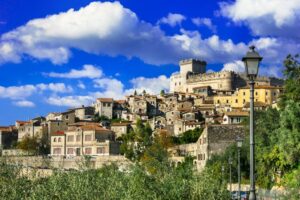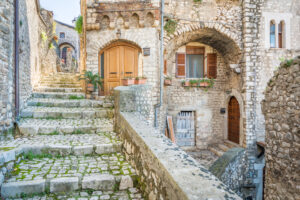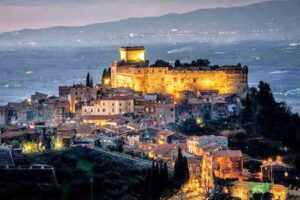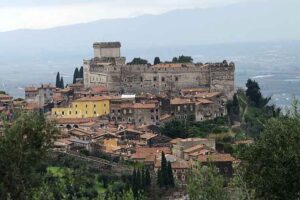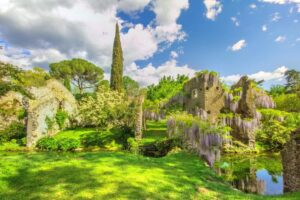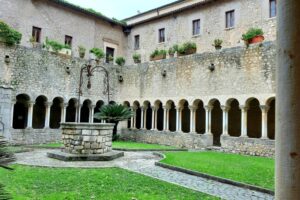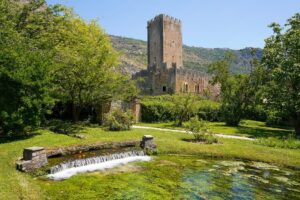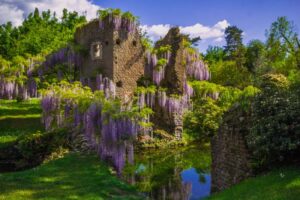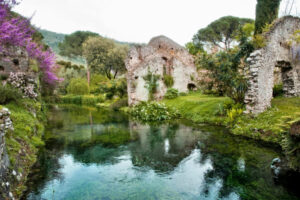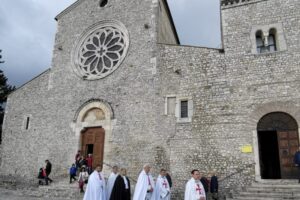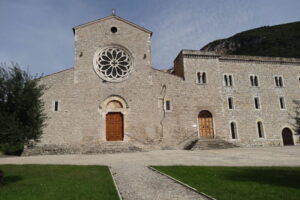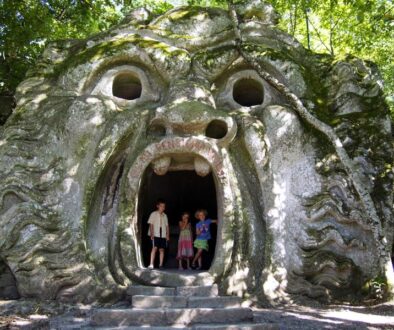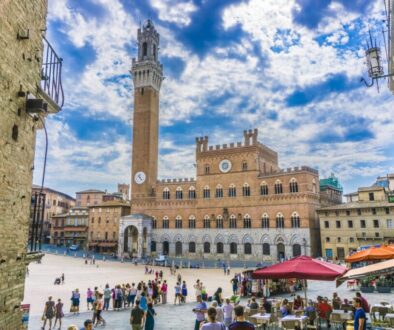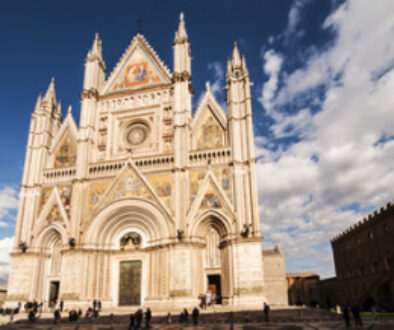Ninfa Garden’s, Sermoneta and Bassiano Medieval villages, Ranch Safari in the Jeep with light lunch Bio Food, and wine Tasting
(1,30 hours drive from Rome)
Sermoneta
The hill town of Sermoneta is situated within the Province of Latina, a distance of 83 kilometres south east of Rome, the regional capital of Lazio. Standing at an elevation of 257 metres above sea level it has a population of around 10,000 residents.
Sermoneta is a captivating hilltop town located in the region of Lazio, Italy. Situated in the province of Latina, this medieval gem offers visitors a journey back in time with its well-preserved historical architecture, ancient walls, and scenic views of the surrounding countryside.
Sermoneta has ancient origins, dating back to Roman times when it was known as “Caetra.” During the Middle Ages, the town developed as a fortified center, and its strategic hilltop location made it an important defensive stronghold. Over the centuries, Sermoneta was ruled by various noble families, including the Caetani and the Colonna.
The town’s historical heritage is evident in its medieval walls, narrow alleys, and historical buildings. Today, Sermoneta is known for its historical charm, architectural richness, and breathtaking panoramas.
Nearby places of interest include the Garden of Ninfa:
If you’re looking for a magical and off the beaten path place to visit during your Italian holiday, the Garden of Ninfa is the place for you. Often dubbed the most romantic garden in the world, this place feels like a faraway land of enchantment. The Ninfa Garden Italy (and the village it takes its name from) is located 64 km southeast of Rome, at the base of the Lepini Mountains. Its balance of nature made the Lazio Region declare it a Natural Monument. Besides being the perfect day trip for couples, it’s also a great resting place when traveling between Rome and Naples. Because of its lovely lakes, colorful vegetation and beautiful medieval ruins, Ninfa Garden is no less than a dreamy place to visit.
Back in the Roman era, in the current village of Ninfa stood a temple dedicated to the goddesses of spring water, the Naiad Nymphs. Back in those days, Romans believed that nymphs dwelled by springs and rivers, hidden in groves and grottoes. And there’s plenty of that to go around in the Giardino di Ninfa!
Fast forward a couple of millennia, and the area has retained its name, though not much is left from that time. Today’s Ninfa Garden mainly consists of flowers and plants that grow abundantly on the medieval ruins of the village.
The village of Ninfa was founded during the Roman times, and it was a rich town in the early centuries of the Middle Ages. A lot happened during the 12th century, as Pope Alexander III was crowned there and decades later the Holy Roman Emperor Frederick Barbarossa sacked and burned it down. Still, the town bloomed again with over 100 homes, a few churches, mills, bridges, a town hall and a castle. Huge guard towers stood outside the gates, protecting the village. However, it was later destroyed in the 14th century.
BASSIANO
Bassiano, nestled between the Lepini mountains is located near Mount Semprevisa, one of the highest mountains in the province of Latina, its origins are still a mystery today. Some attribute them to mythological deities, some to Roman emperors boasting that Bassiano was founded by the emperor Caracalla, there are those who attribute the name to San Bassiano bishop of Lodi. What is certain is that Bassiano was inhabited around the 10th century by a small group of shepherds and farmers forced to take refuge from the barbarians, in this place completely covered from the view of the plain. The historic center of the medieval village of Bassiano has a characteristic spiral structure and is surrounded by walls and “tower houses”. Among the things to see in the historic center, Palazzo Caetani is definitely not to be missed, the ancient feudal palace built by the Caetani in the sixteenth century and currently home to the municipal administration and the Museum of Scriptures. We then find the birthplace of Aldo Manunzio, a famous sixteenth-century publisher, the Church of San Nicola with numerous frescoes including some scenes relating to the woman struck by the plague and to Herod and Salome, the church of Sant’Erasmo and the former church of Santa Maria now deconsecrated.
Finally, we recommend passing by the Piazza della torre and the suggestive panoramic terrace, without forgetting to get lost in the alleys of the village! 🙂
When talking about Bassiano, we cannot forget its food and wine excellences including the Prosciutto di Bassiano famous throughout Italy for its rich flavor, the extra virgin olive oil obtained with mechanical processing, the sausages, the coppiette, the cheeses and the typical desserts.
Guided tour of the winery – Premium Tasting
Description
What is included
Duration: 10 hours
Text content
